The Dragons and Damsels of Elm Creek
By John Palka — Posted July 19, 2020
The last piece I wrote for Nature’s Depths, dated November 24, 2019, bore the name “Beauty and Love.” Seven months and more have passed since then, seven months since my beloved of sixty years left this world, seven months since my life was permanently changed. And yet, some important things have not changed, and walking in Nature with open eyes, an inquisitive mind, and a responsive heart is one of them. So, I invite you to come with me on a walk along the trails of the Eastman Nature Center here in Maple Grove, Minnesota, and revel in Nature’s beauties and her endlessly fascinating ways of life.
ELEGANT NECTAR-FEEDERS
Long stretches of the trail meander through beautiful restored prairie laden with brightly colored flowers.

Many of these flowers are visited for their nectar by butterflies. A butterfly has an astonishing feeding tube called a proboscis, just like the technical term for an elephant’s trunk. The proboscis remains coiled up against the butterfly’s face until it is time to probe for nectar. Then this tube is extended to an astonishing length so it can reach the nectar droplet hidden deep within the flower.
You can see glimpses of this feeding process here, carried out by two of America’s most beloved butterflies. In the first picture, a monarch (Danaus plexippus, Family Nymphalidae), is perched on a gray-headed coneflower (Ratibida pinnata, Family Asteraceae) while its proboscis is still tightly coiled underneath its head.
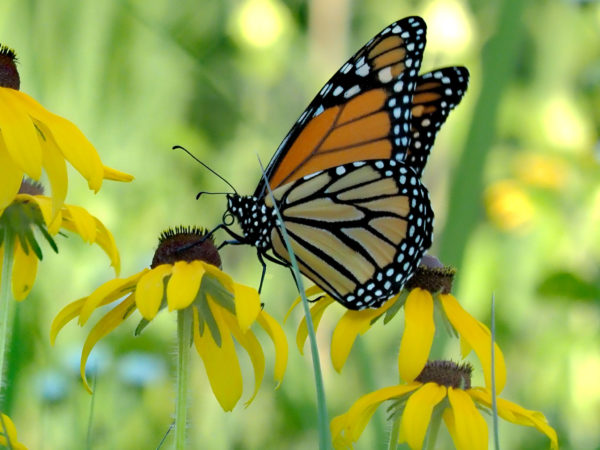
In the second picture, the proboscis of an eastern tiger swallowtail (Papilio glaucus, Family Papilionidae) is fully extended and is probing the flowers of the wild bergamot or bee balm (Monarda fistulosa, Family Lamiaceae).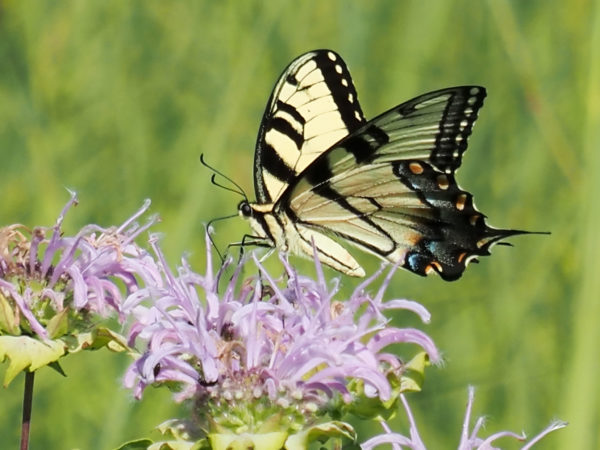
There are many other insects, and also specialized birds like hummingbirds, that come to flowers to drink their nectar. Flowers produce the nectar at considerable metabolic cost. Why do they do this? Because in the process of drinking, butterflies, bees, and other visitors spread pollen from one flower to the next. Flowers have evolved characteristics—notably color and odor— that attract pollinators, and pollinators have evolved sensory capabilities to recognize and respond to these attractors. Such an interactive process is often called co-evolution. It is widely accepted that the co-evolution of flowers and insects was a major factor in generating the huge diversity that we see within both groups.
UNRELENTING PREDATORS
Plants get the energy they need for growth, and also for making nectar, directly from the Sun through photosynthesis. Some animals eat plants or drink their juices the way our butterflies do, so the Sun provides their energy for life as well, though indirectly. Other animals—carnivores—eat animals that eat plants, so their lives, too, are dependent on the Sun. The other group of beauties at Eastman Nature Center that we will focus on in this post, the dragonflies and damselflies, belong in this category.
Over the meadow in which monarchs and fritillaries flit about, you can also see the much faster and more directed hunting flights of dragonflies. The main strategy of these unrelenting predators is to perch in a location that will allow them to spot other insects flying by, zoom off after a likely target, and then return to their perch. The whole hunting expedition may last only a few seconds. The fact that the hunter/huntress tends to return to the same perch multiple times is very convenient for the photographer!
Here are some examples of the beautiful dragons at Eastman. As it happens, all of them belong to the family Libellulidae.
A male widow skimmer (Libellula luctuosa).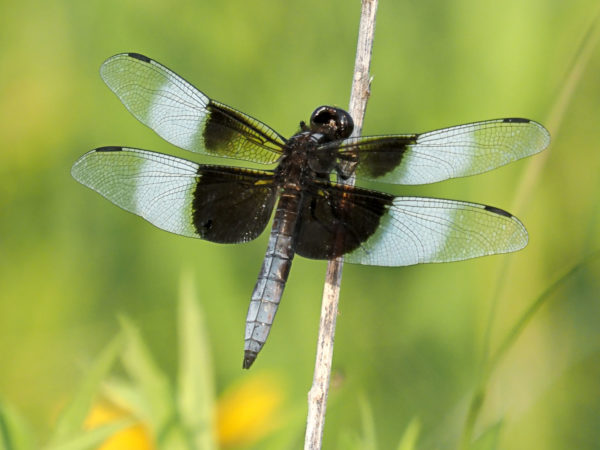
A female widow skimmer.
A female Halloween pennant (Celithemis eponina).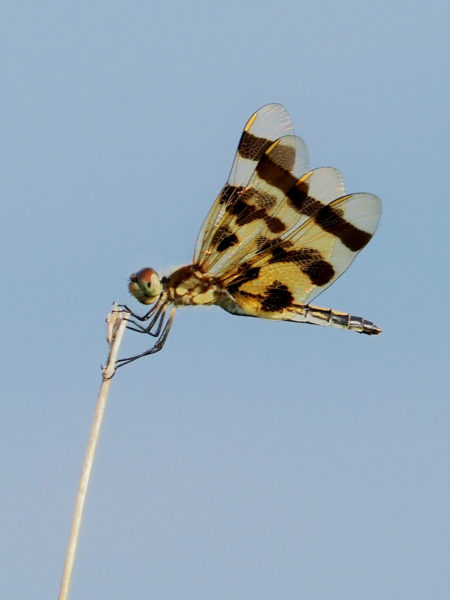
A male twelve-spotted skimmer (Libellula pulchella).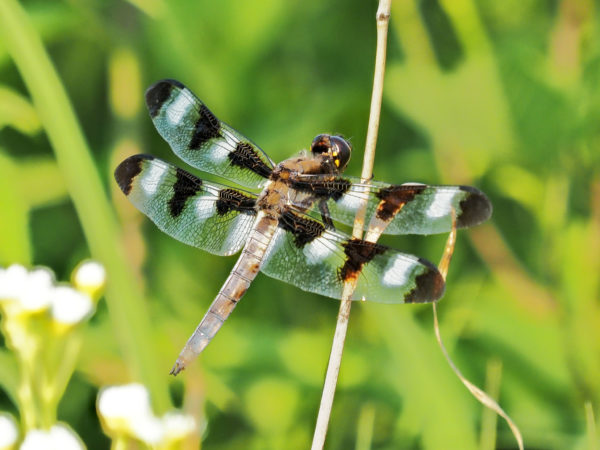
A female ruby meadowhawk (Sympetrum rubicundulum).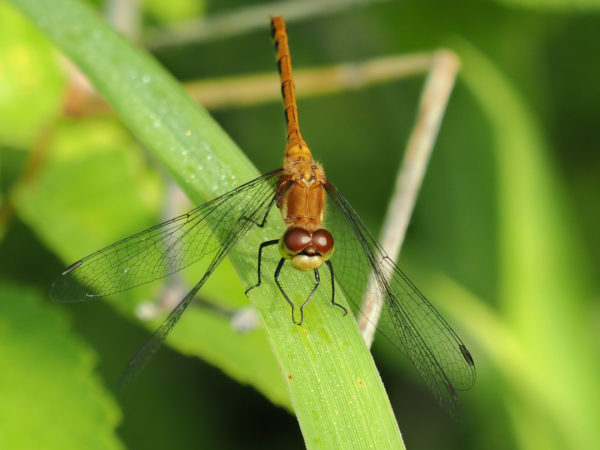
If we keep walking until we reach the edge of the woods, we will find that dragonflies abruptly become rather scarce. In their place appear many damselflies, closely related insects (both belong to the order Odonata) that are also predatory but that differ from dragonflies in a number of ways. For example, when at rest damselflies hold their wings directly above the body rather than spread out. Their bodies are far more slender and delicate-looking than are those of dragonflies. And their flight is less powerful and somewhat reminiscent of that of butterflies.
Thus far, all the damselflies I have seen at Eastman have been of a single species, the ebony jewelwing (Calopteryx maculata, Family Calopterygidae), often also referred to as the demoiselle.
A male ebony jewelwing (demoiselle).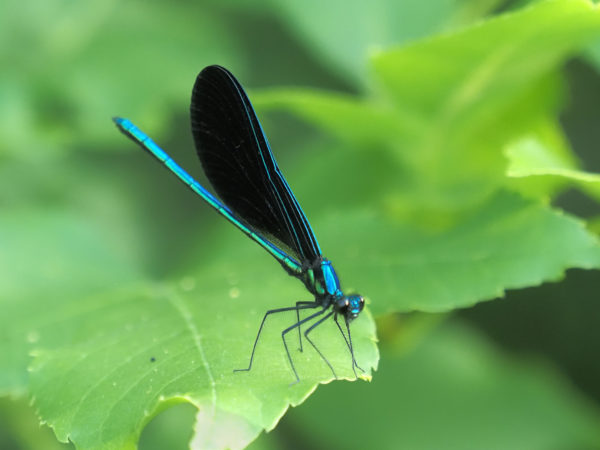
A female ebony jewelwing (demoiselle).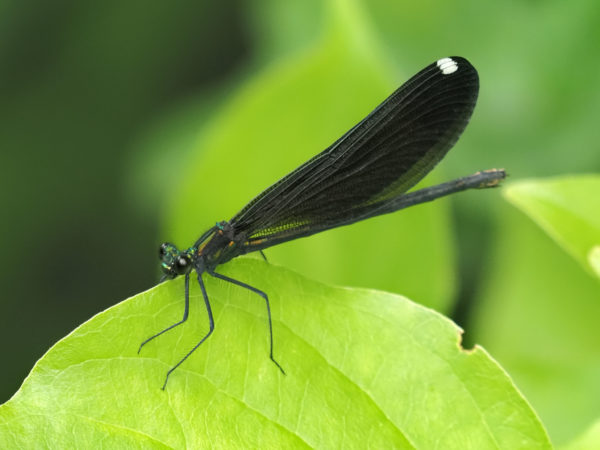
And here is a picture of hunting success for such a female.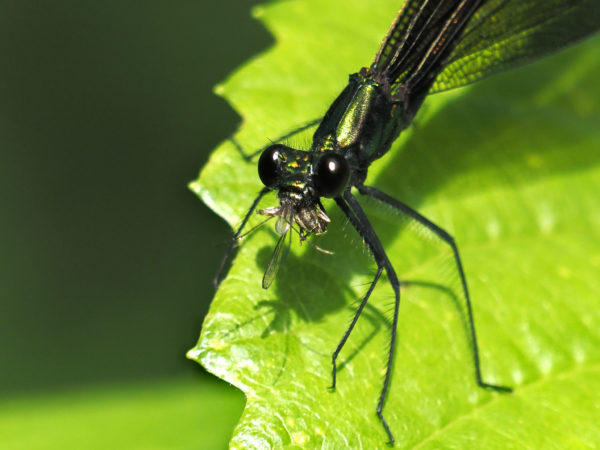
HUNTING BY SIGHT
Both dragonflies and damselflies hunt by sight. This means that they have to recognize their prey against whatever background is around them. Then they have to track that prey while both hunter and potential victim move relative to one another and relative to the background. This a major computing challenge for their visual systems!
Dragonflies have it a little easier. More often than not, while they are hunting they see their prey against the sky. This forms a fairly uniform background, so that recognizing the prey against distractions such as textured bark or leaves is not an issue. Damselflies, on the other hand, hunt primarily along the edges of woods where distractions abound.
Here is a picture of the hunting apparatus of the ruby meadowhawk we saw in the last photograph of dragonflies above. The stiff and pointed spines on the legs help in prey-capture. The legs can form a basket around the prey and the spines effectively trap and immobilize it until the hunter or huntress can grasp it with her jaws. 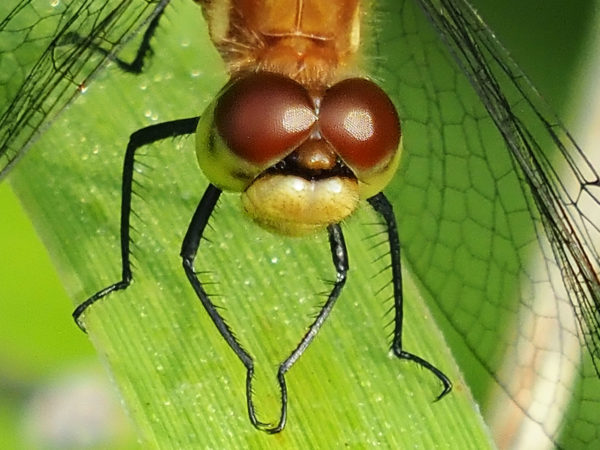
The eyes are enormous and elaborate, meeting in the midline on top of the head and extending alongside the face almost to the bottom and thereby covering most of the head. The very front of the face is part of the jaw apparatus.
The eyes of insects, as well as of crustaceans like crabs and shrimp, are built very differently from our own. Rather than having a single large lens, the entire surface of the eye is covered with a mosaic of tiny lenses (facets), each looking in a slightly different direction and each backed by an optically separate micro-retina whose cells send signals to the brain. This is called a compound eye. If you look carefully at the shiny disc atop each eye in the picture above (simply a region from which the light is reflecting especially conspicuously), you can see a fine pattern of very thin lines. These lines are the boundaries between adjacent facets.
A pair of eyes like this, each covered with thousands of facets, is very good at providing a simultaneous view of a huge portion of the animal’s total visual world. This is great for spotting a tiny potential prey that could be anywhere. The tiny size of each lens limits the detail that it can resolve—for physical reasons, large lenses yield sharp images and small lenses yield fuzzy images—but that’s OK if the task is simply to recognize the presence and location of a potential meal. The facets on top of the eye, in this species colored brownish, are somewhat larger and yield more detail. The angles between them are also smaller, which allows for more precise localization. So, the dragonfly uses this part of the eye to zero in on its prey. It usually approaches the prey from underneath, thus taking advantage of the better optics. The smaller lenses in the lower part of the eye, in this species colored green, are used for more general viewing of the visual world.
Now here is a corresponding view of a male ebony jewelwing, the damselfly that is currently so abundant around the Eastman Nature Center.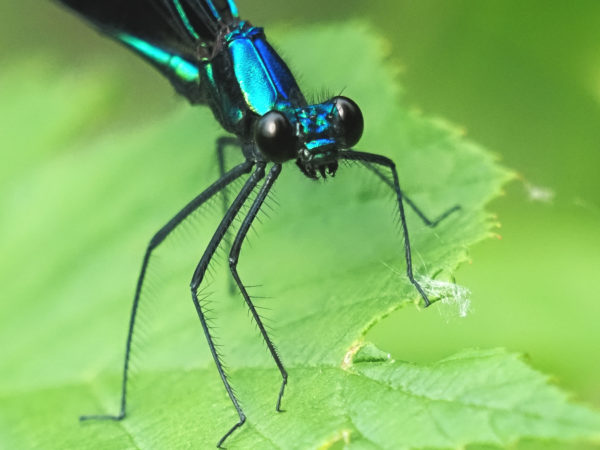
Like the meadowhawk, the jewelwing has prey-trapping spines on its legs (and fierce jaws!). And like all dragonflies, damselflies, too, have compound eyes. But notice the difference in arrangement. Where the two eyes of the meadowhawk met in the midline, the eyes of the jewelwing are separated by quite a gap. This difference applies generally to dragonflies and damselflies. What might it signify?
One interpretation is that the difference in the geometrical arrangement of the eyes reflects the different hunting environments of dragonflies and damselflies. When the prey can be seen against a smooth sky, the hunter’s eyes can be optimized for high-precision tracking. When the prey is flying in a world of vegetation, however, the challenge is different. It is necessary for the predator to distinguish the prey from multiple other objects, and to do this even while flying on a trajectory calculated to intercept the prey. Simultaneous input from more widely separated eyes is believed to facilitate this complicated computational task.
HOW OUR UNDERSTANDING GROWS
You might well wonder, how effective are the hunting systems and behavior of dragonflies and damselflies? A few years ago, the New York Times reported on some studies that provided an answer to this question. The data showed a success rate for dragonflies in the vicinity of 95 percent! In comparison, the estimates for great white sharks were 50 percent and for lions 25 percent.
I am very fond of stories like this, and of the growing number of very sophisticated papers analyzing how the nervous systems of dragonflies and damselflies provide the necessary information, especially because one of the leading researchers in the field, Robert M. Olberg, is a former PhD student of mine at the University of Washington. In fact, I even taught him as an undergraduate at Rice University, so Rob and I have known each other for fifty years!
We can learn something important from the story of Rob’s life in research. He submitted his PhD dissertation in 1978 and he’s been studying how the nervous systems of dragonflies, and more recently damselflies, recognize prey under a variety of conditions ever since. This shows something important about science and scientists. Gaining deeper understanding, whatever the question is, takes time, effort, perseverance, and ongoing curiosity. Answers rarely come in a flash. Even when sudden insight is a key ingredient, that insight has to be tested meticulously, and typically that’s difficult and time-consuming to accomplish.
Equally important, science is a social world in which collaborative efforts are increasingly the norm and personal friendships play a huge role. Rob’s latest paper, comparing nerve cells in dragonflies and damselflies (the same ebony jewelwings we have encountered at Eastman), came out in February of this year, 2020. There were six authors who work on three continents. Three of them work at Cambridge University in England; one at Southeast University in Nanjing, China; one at Union College in Schenectady, New York (that’s Rob); and one at the University of Minnesota here in Minneapolis.
Beyond this, more than forty years after Rob submitted his dissertation, he (and his wife Andrea, who was also a graduate student at the University of Washington and often collaborates with him) and I are still active friends. This is the real world of science, unfortunately often hidden from public view—a world of excitement, of curiosity, of perseverance, and of personal friendship.
KEEP ON LOOKING
Now back to Eastman. If you keep peering into the vegetation alongside the trail, especially around a stream or pond, you may spot male and female dragonflies or damselflies close to one another. Sometimes this is coincidence, sometimes it is courtship.
If the male succeeds in courting the female, sometimes enticing her with special wing movements, he will be able to grasp her behind her head using specialized appendages at the tip of his abdomen. The iridescent male in the middle of the picture below has done just this with the female who is directly behind and aligned with him. The purpose of this maneuver is mainly to keep the pair together against attempts by other males to dislodge them. The pair can even fly around together in this configuration. 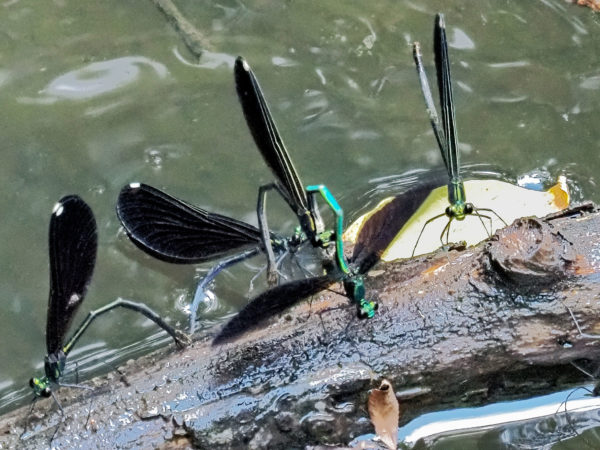
If the female is ready to mate, she will flex her abdomen sharply toward the front of the male, find a pore underneath the front of his abdomen where he has stored his sperm, and attach her own genital opening there. You can see a mating pair of ebony jewelwings in the picture below (male in the upper left, female in the lower right) and a more detailed view of the connection for sperm transfer in the subsequent enlargement. 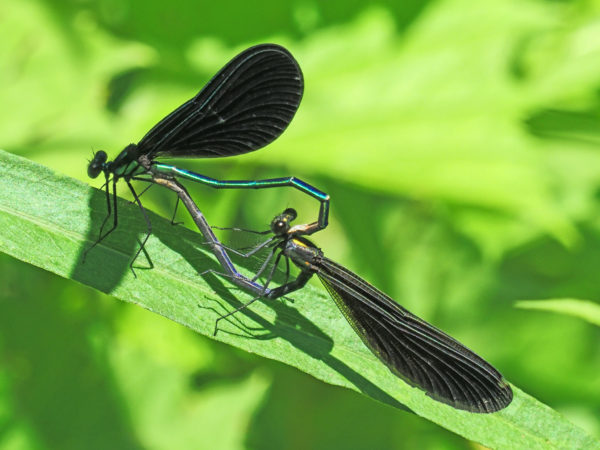
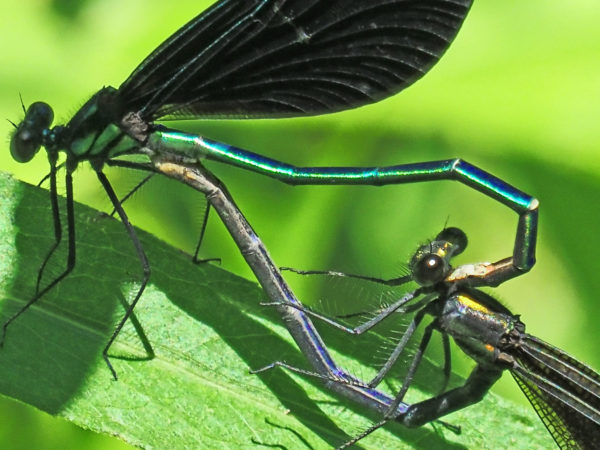
Now here’s an amazing step in the mating process, a step that is internal and cannot be seen in photographs. The female does not make her eggs immediately accessible to the male’s sperm. Rather, she stores the sperm in a pair of sacs. When she is ready to lay her eggs in the water, where they will develop into aquatic larvae which are also fierce predators, the passage of the eggs on their way out of her body triggers the release of the stored sperm, so that fertilization takes place immediately before egg laying. Not what we are accustomed to! And it has a remarkable accompaniment. A male’s first step during mating is to clear out of the female’s storage sacs any sperm she might already have stored from a previous mating. Only then does he inject her with his own sperm. This two-step process ensures that the next generation will bear his genes, not his competitor’s genes. How effective is the removal of competing sperm? Experiments show that it can be close to perfect—upward of 95 percent. Mother Nature is endlessly inventive!
Now here’s my invitation: When you next go out walking, see if you can spot butterflies enjoying their sweet drinks and dragons and damsels perching and hunting. Imagine what it might be like to be one of these treasures of Nature, to be looking out at the world through compound eyes and experiencing it through the workings of a nervous system that is highly tuned to brightly-colored containers of sweetness or tiny dark objects dancing about. As you do this, remember that the components of the living world around us are profoundly interdependent, primarily because they (and we as well) are the products of millions of years of evolution and of fine tuning to one another. This is not a matter of chance. Rather, it is a matter of trial and error, with the most successful versions surviving and reproducing. Nature has created herself in a way that works magnificently well, and we can learn a great deal by paying attention to what she has to teach us!

Dear Johnny, what a treat to find this in my inbox this morning! Thank you for compiling the lovely photos and the commentary about what you’ve seen and putting them both out here where others can enjoy them. I did not know Yvonne well, but my heart aches for your loss, at the same time rejoicing that you had such a long and loving marriage. I am so glad our paths crossed on Whidbey Island.
Thank you, Kit. And I, too, am glad that our paths crossed!
A marvelous return Johnny – nature comes alive in your remarkable observations! The enduring love and presence of Yvonne shines through. I was particularly touched by your obvious joy as you shared the history with your student – such a sweet expression of science at its most caring..!! The carnivores in our backyard will never again be strangers — thank you
– Marty
Thank you so much for your heartwarming response, Marty. It’s connections like this that make assembling posts so rewarding.
Dear Johnny, I love this exquisite piece of photography and writing, It is endlessly, delightfully educational. So very good to see you writing again. Can scarce imagine your journey these last 8 months, but so glad you are close to family—especially during COVID. Blessings, Ann
Thank you, Dear Ann!
Dear Johnny, I like to believe that Yvonne and Dawna are together and full of joy as you remind them of the miracles of this world. Thanks so much.
Love
Nick
What a wonderful vision, Nick. Thank you!
You write so beautifully and lucidly, Johnny. Glad to see you back at it.
Thank you, Michael. I much appreciate your comment! And I, too, am glad to be back at it. I’m already working on the next one!
The complexity of perfection in Nature inspires me over and over again, and your skill in bringing this new news to me regarding dragonflies and damsels wakes up my brain on a Sunday afternoon. thank you! I’ll be looking differently at these creatures, and glad to have your voice back in the world. Wizard of wonder and science, blessings on your journey.
Thank you for those words and blessings, Christina!
Dear Grandpa Johnny,
Terran and I loved reading this! It makes me so happy to imagine you walking around Eastman, exploring the trails you and grandma always loved. She always knew how to find the dragons, no matter how small. These pictures are incredible! Terran is amazed by your photography! We miss and love you lots!
Love,
Mia and Terran
You’re so right about Grandma, you two. You saw right away where the title of the post came from! Eastman has been inspiring, and today I managed a picture that will be the foundation for the next post. I was amazed when I saw it!
Dear Johnny,
So happy to see this next installment of your vision and inspiration. As always, I learned a lot and look forward to a visit where there is water and these amazing insects to admire. Take care, we miss you!
Linda
Thanks, Linda. It was uplifting and energizing to put the post together. I have been going to Eastman almost every day. That’s something that Yvonne and I loved to do together, so it feels like both a return to a way of paying attention to nature and a way of connecting with Yvonne. I have no intention of stopping!
Johnny,
What a wonderful exploration of the magic of nature.
You have brought a breath of fresh air into the semi incarceration we are experiencing at this time. The intimacy of your art is appreciated.
Love
Ernie
Thank you so much, Ernie. It is wonderful to see my efforts regarded as art, and even intimate art. Yvonne would have celebrated your words with me!
So good to hear from you. A friend remarked to me that he never thought that there were miracles in nature. I’ll share your beautiful example of miraculous process of co-evolution, the beauty of our co-creating community of beings. Thank you for sharing your gift with us.
Please let me know what your friend says. I’m very curious!
Oh Johnny, thank you so much. You have opened my eyes so that I may see dragonflies and damselflies as never before. Your blog and photographs are beautiful! Now that our access to nature is so limited we can still learn and enjoy from your amazing writings and photos.
Thank you, Debbie. Preparing this post was a special pleasure, especially under the circumstances of Yvonne’s passing.
Johnny, I am so grateful to you for this! Your photos are as amazing as your writing. Just last week at Meadowbook Pond I saw what my friend said was an 8 spotted skimmer, and now I know what it was doing jumping off its perch and back on it several times, having a snack!!!
I think of you often even though I didn’t spend nearly enough time with you and that lovely Yvonne.
Shambhavi
Thank you, Shambhavi. Isn’t it amazing what you can see when you pay attention? It’s a little like focusing inwards and being amazed at all that is there!
So good to hear from you, Johnny, and to read your delightful post. It took me back to my childhood living in Japan with an abundance of dragonflies. I would stand still with my arms outstretched and be covered with them – magical! Thank you for the memories!
Covered with dragonflies – Wow! Magical indeed!
Johnny, I sent it to my friend who showed me theses at the Pond, and wanted you to see her response! “This article is absolutely fabulous. We will never look at the dragons and damsels of Meadowbrook pond with the old set of perceptions again.”
Well this is just fabulous, thank you John. You’re teaching me how to see, and rekindling wonder at it all. Thank you for blessing us with your abundant knowledge even in the wake of your immense loss. Thinking of you from Whidbey.
Thank you, Tom. Many people have said that Mother Nature is very healing. I am certainly finding that to be true.
Hi Johnny – My friend, Lynn Brevig, forwarded this post to me today. What a treat to read this “story” and see these incredible photos! I was very sorry to learn of Yvonne’s passing and glad to hear you are carrying forth so beautifully. Galen & I moved (down-sized)recently, but are still very close to the Meadowbrook Pond, so learning more about these amazing creatures is delightful. Our best to you. – Sandy Wood
Dear Sandy – Wow, another demonstration of how interconnected our world really is! It’s so great to hear from you after all these years; Yvonne would have been delighted as well. I’m glad the story caught your imagination!
Fascinating and lucid, and the photographs are amazing. How fortunate we are that this kind of writing and photography can be part of your healing process.
Thank you, Steve. I feel very fortunate as well. Every time I go out to Eastman, which is almost every day, I feel restored to the way life was when Yvonne was with me. Fortunately, that feeling lasts a long time – it is truly healing.
Dear new friend,
My heart aches for your loss but rejoices in the love you shared with Yvonne. Thank you for the privilege to get to know your through your passion for nature, a passion we share. The photos are exquisite but what I enjoy the most if your gift of writing. Thank you again for teaching me the wonders of Eastman. I am hoping to cross our paths there soon again, after all you could say Elm Creek is my backyard. Thank you!
Thank you, Paula. Perhaps something will also come of the potential connection with your community college program that we talked about.
This is lovely, especially your comments about the interconnectedness of all things. We have a more limited supply of dragonflies and damselflies in the uplands of Northumberland, but I still love them. Thank you for your detailed observations.
Thank you, Karen. And I’m thrilled to discover that I have a reader far away in the UK!
I am fascinated by the differences in abilities/adaptations of these related species. I happened to be listening to Birdnote today and learned a new word, ecotone, naming the border that damsel flies inhabit. The Birdnote piece was about Indigo Bunting, another very colorful species. I started wondering about coloration of animals that inhabit borders between forest and meadow, land and water, forest floor and understory brush, etc. You always send me on thought journeys! Thank you.
Thanks for your comment on thought journeys, Marc. It’s wonderful to hear that, ‘cuz that’s one of my main goals!
Very enjoyable read Johnny. In my many years of doing field work as an aquatic biologist, work would pause as I would stop and marvel at the flying aerobatics of dragon and damsel flies. Next challenge: make a video of either “planting” their eggs in the water. I’ve seen this marvel many times; how they fly fast over the water’s surface and dip, dip, dip the end of their abdomen in the water. Good luck if you try.
All the best!
Dan
Thanks, Dan. I’m just learning how to take videos. If all goes well, there will be a couple on the next post which will focus on those other amazing meadow jewels, the butterflies.
Johnny, these images, especially the close-ups, are more astonishing than ever! Your clarity and precision are just stunning. Are you still working with your original Olympus or have you graduated to something even more wondrous?
AND it’s great fun to read the details of these critters’ habits. Oh my goodness…….
Thanks, Larry. Olympus forever!
I’m appreciating that the color of the male ebony jewelwing that works so very well for this damselfly is also so very beautiful to our human eyes.
Amazing, isn’t it. Now we get to wonder about why that might be!
John,
We met yesterday on the trail at Eastman. I greatly enjoyed our conversation, and I read this blog today. You have a good touch on how to write clearly and interestingly. I intend to catch up with the rest of your blogs.
Thank you, Dave.